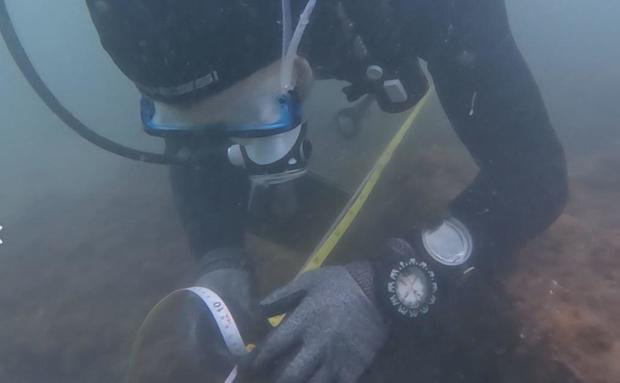Researchers unearth
An investigation into a Spanish warship that sank over 200 years ago has revealed “buried secrets” including well-preserved structural details, Spanish authorities announced Thursday.
The Santa María Magdalena, a Spanish Navy frigate that was sunk by a powerful storm in 1810, is currently the subject of an “exciting investigation” by the Spanish Federation of Underwater Activities, according to a news release from the agency. The effort first aimed to preserve the ship, which remains underwater, but has “evolved into a saga of astonishing discoveries,” the agency said. The ship is the only wreck of its time currently being excavated in Spain, and was featured in a 2020 documentary looking at its history.
Spanish Federation of Underwater Activities
The story of the ship’s sinking began in October 1810, when the it set sail as part of a Spanish-British collaboration to take a city that was under French rule during Spain’s War of Independence. The ship had 34 guns and a “rich history of service,” the agency said, but after losing its anchors, it was caught in a “sudden and violent storm” that led to its sinking in November 1810. An estimated 500 sailors and soldiers were aboard at the time, making it “one of the greatest maritime tragedies” in the country’s waters. According to wrecksite.eu, an online database that tracks shipwrecks, just eight men survived and swam to shore. Five of those men died from their injuries.
One major discovery, the agency said, was that as the ship was being excavated, it was found that around 86 square feet of the lining boards along the frigate’s bilge are “free of structural or biological damage.” The bilge is where a ship’s bottom curves to meet its sides. The ship is “truly unique” because of this preservation, the Spanish Federation of Underwater Activities said, and overall, the ship is in an “exceptional state of conservation.”
Spanish Federation of Underwater Activities
According to local newspaper La Voz de Galicia, the purpose of the expedition is to map the structure of the ship and understand how it was built. This means that researchers have to work underwater to clear sand and sediment from the ship.
Underwater archaeologist and lead investigator Antón López told La Voz de Galicia that researchers had found “ballasts and ammunition” aboard the ship, calling it a “real underwater museum.”
Spanish Federation of Underwater Activities
The Spanish Federation of Underwater Activities said that these discoveries allow Spain’s naval history to emerge.
“Each find is a tribute to the brave sailors and soldiers who braved the treacherous waters more than two centuries ago, and a tribute to their legacy that endures through time,” the agency said.
Thanks for reading CBS NEWS.
Create your free account or log in
for more features.
For all the latest Automobiles News Click Here
For the latest news and updates, follow us on Google News.





